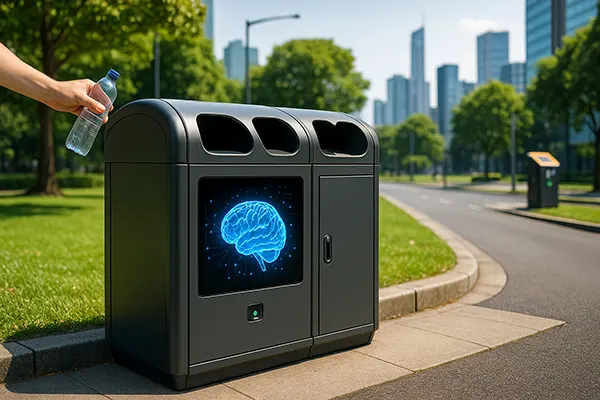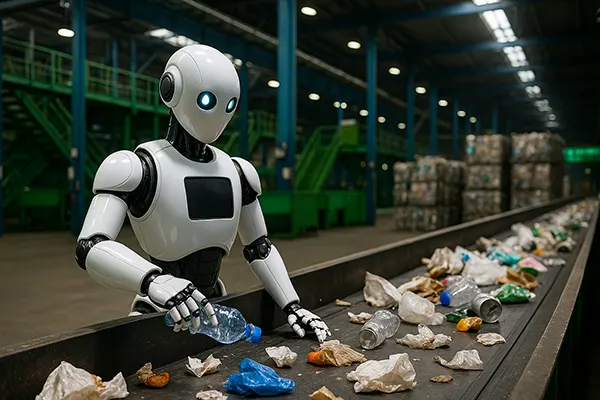
Smart Waste Bins in Urban Environments: How AI Learns to Sort Waste
As urban areas expand and sustainability targets grow more ambitious, waste management becomes a critical issue. Traditional bin systems are inefficient in densely populated cities, often leading to overfilled containers, incorrect disposal and high operational costs. The integration of artificial intelligence (AI) into smart waste bins offers a timely solution, combining sensor data, machine learning and automation to transform how cities handle their refuse.
AI-Powered Bins: Technology Behind the Smart Waste Revolution
Smart waste bins use a combination of optical sensors, weight detectors, image recognition systems and connectivity modules to collect real-time data on deposited waste. These technologies help monitor bin levels, identify the type of waste and send alerts to municipal services when collection is required. The use of IoT (Internet of Things) ensures that bins can “communicate” with central systems, improving logistical efficiency and reducing fuel consumption for waste collection trucks.
In recent developments, AI systems have been integrated with computer vision capabilities. Using datasets trained on thousands of images, these systems can identify materials such as plastic, paper, glass or organic matter with a high degree of accuracy. This real-time recognition enables correct sorting even at the bin level, guiding users through displays or voice instructions on where to deposit each item.
Furthermore, these smart bins adapt over time. As AI algorithms are exposed to new environments and waste variations, they continuously learn from user behaviour and refine their sorting models. This learning loop is crucial in multicultural cities where recycling habits vary significantly across districts and demographics.
Machine Learning in Waste Classification
Machine learning models used in waste classification rely heavily on labelled training data. Engineers and researchers first collect vast datasets of waste item images, each categorised into recyclable and non-recyclable categories. These datasets are then used to train convolutional neural networks (CNNs) that mimic the human ability to visually distinguish between objects.
Once trained, these models are embedded into bin-mounted microcontrollers or connected cloud systems. The bin’s camera captures images of each deposited item, and the AI model predicts its category with a probability score. In cases of uncertainty, bins can even request user input through simple interface prompts, feeding new confirmed data back into the system.
This self-improving design ensures that smart bins stay effective even as packaging materials evolve or local regulations shift. Models are periodically updated with regional variations, which has proven effective in trial runs across European cities such as Helsinki, Amsterdam and Vienna.
Environmental and Operational Benefits for Smart Cities
The implementation of AI-driven bins has shown measurable environmental benefits. One of the most significant is the reduction in contamination rates. By ensuring that recyclable materials do not end up in general waste streams, cities can significantly reduce landfill use and improve the quality of materials sent for recycling, which lowers processing costs.
Operationally, smart bins enable municipalities to optimise collection routes. Real-time fill-level data eliminates unnecessary truck deployments, which reduces fuel usage, carbon emissions and labour costs. Some cities have reported up to 40% reduction in collection costs after adopting smart waste systems.
Additionally, AI-powered waste bins contribute to citizen engagement and education. Interactive interfaces inform users about recycling practices, while mobile apps linked to bins can offer rewards for correct disposal. Such gamification methods have been piloted successfully in Seoul and Barcelona, increasing public participation in waste reduction initiatives.
Integration with Broader Smart Infrastructure
Smart bins do not function in isolation; they are a part of the broader smart city ecosystem. When integrated with traffic systems, weather forecasts and demographic data, waste management becomes even more predictive. For instance, bins in tourist-heavy areas can anticipate surges in waste during festivals or events, allowing services to adjust in advance.
These systems also provide valuable data for policy development. Municipalities can analyse long-term trends, identify areas with low recycling compliance and tailor public awareness campaigns accordingly. This data-driven governance makes urban sustainability planning more effective and transparent.
Moreover, the integration of renewable energy sources—such as solar panels powering the bin sensors and communication systems—makes these solutions even more environmentally sound. Solar-powered smart bins have already been installed in London, Sydney and New York, demonstrating the scalability and flexibility of this technology.

Challenges and Future Directions
Despite the promise, several challenges remain. One of the primary obstacles is cost. The initial installation and maintenance of smart bins, especially with advanced AI capabilities, can be expensive for smaller municipalities. Securing long-term funding and demonstrating clear return on investment are critical for widespread adoption.
Another concern is privacy and data handling. While most bins only use visual data for item classification, ensuring compliance with data protection regulations remains essential, particularly in regions governed by strict laws such as the GDPR. Vendors must ensure transparency and user consent for any data collection involved.
In the future, improvements in edge computing may allow for faster and more efficient local processing of waste images. Additionally, AI models trained with federated learning could improve bin intelligence without transferring personal data to central servers. Innovations in biodegradable sensor materials may also reduce the environmental footprint of smart waste hardware itself.
The Role of Policy and Public Participation
Government policy will play a key role in the mainstreaming of AI waste technologies. Public procurement regulations, subsidies and standardisation frameworks are needed to encourage private sector involvement and ensure interoperability between different vendors’ systems.
Equally important is public trust. Community engagement initiatives, such as participatory design workshops and pilot programmes, can help align smart waste technologies with real user needs. Educational campaigns must go beyond awareness and empower citizens with practical knowledge about AI’s role in sustainability.
Ultimately, intelligent waste bins represent just one facet of a much broader shift towards data-driven, environmentally responsive urban living. Their success depends not only on technological refinement but on inclusive, transparent and collaborative implementation strategies.





